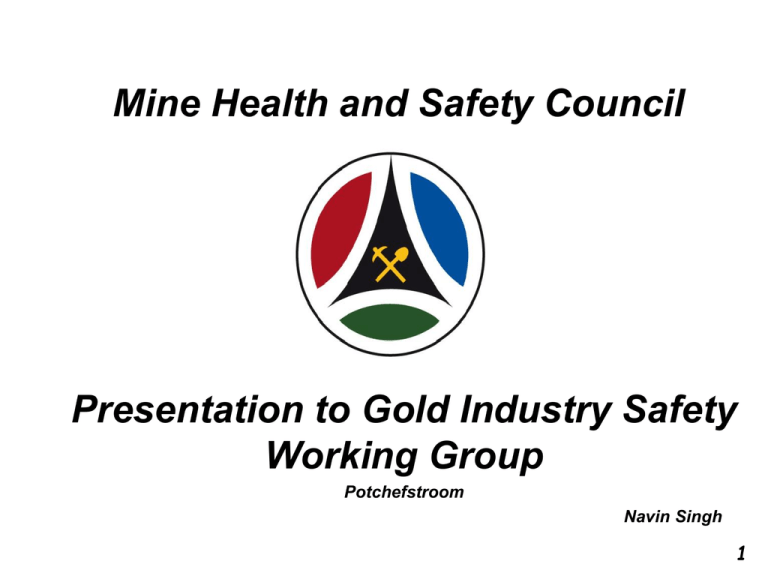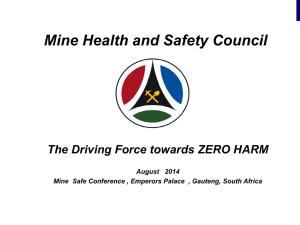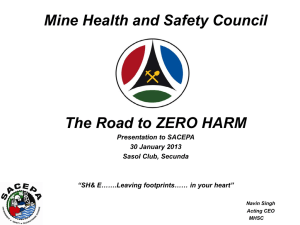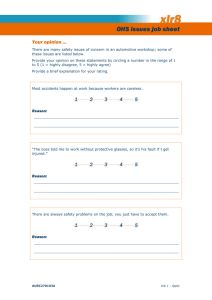presentation to Gold Industry Safety Working Group
advertisement

Mine Health and Safety Council Presentation to Gold Industry Safety Working Group Potchefstroom Navin Singh 1 Contents – The Road to Zero Harm – MHSC Mandate – MHSC Overview – MHSC Objectives – MHSC Initiatives – Attaining ZERO HARM – Conclusions 2 Health and Safety Yardstick Occupational Safety – Fatalities and Injuries – Milestones Industry Target: Zero rate of fatalities and injuries In the Gold Sector: By 2013, achieve safety performance levels equivalent to at least current international benchmarks for underground metalliferous mines In the Platinum, Coal and Other Sectors: By 2013, achieve constant and continuous improvement equivalent to at least current international benchmarks Occupational Health – Milestones Industry Target: Elimination of Silicosis Industry target: Elimination of Noise Induced Hearing Loss (NIHL) By December 2008, 95% of all exposure measurement results will be below the occupational exposure limit for respirable crystalline silica of 0.1mg/m3 (these results are individual readings and not average results) After December 2013, using present diagnostic techniques, no new cases of silicosis will occur amongst previously unexposed individuals (Previously unexposed individuals = individuals unexposed prior to 2008, i.e. equivalent to a new person entering the industry in 2008) After December 2008, the hearing conservation programme implemented by the industry must ensure that there is no deterioration in hearing greater that 10% amongst occupationally exposed individuals By December 2013, the total noise emitted by all equipment installed in any workplace must not exceed a sound pressure level of 110dB(A) at any location in that workplace (includes individual pieces of equipment) Health and Safety Yardstick Occupational Safety – Fatalities and Injuries – Milestones Industry Target: Zero rate of fatalities and injuries Benchmark less than 1 fatality per 33 million hours worked by 2013 Occupational Health – Milestones Industry Target: Elimination of Silicosis Industry target: Elimination of Noise Induced Hearing Loss (NIHL) No new cases of silicosis for new employees from 2008 Deterioration < 10% Noise from any & all equipment < 110 dB(A) The Target ZERO HARM 5 Our track record - Safety Our track record - Safety THE CHALLENGE REMAINS Safety vs. Health • Prior to 2003 milestones, focus was on safety • Respirable related deaths approx 80% Health – Silicosis • Silicosis • OEL of 0.1 mg.m-3 • Country as a whole has steadily regressed. • Only 3/9 provinces showing upward trend • GP, NW, FS combined have largest workforce – 70%, 85% 70% compliance only Health - Occupational Diseases • Same areas in the last few years • SILICOSIS • TB • NIHL Our track record - Safety • Prior to 2003 milestones, focus was on safety • Respirable related deaths approx 80% Safety Statistics - Machinery and Transport Excerpt from summary of Accidents as per DMR website July 2009 • worker was killed when he was caught between two hoppers • A driver lost control of the truck and it drove into a construction crew, killing two workers • A worker was killed when he was caught between a hopper and the sidewall • In another fatal accident a worker died when he was struck by a scraper rope whilst conducting cleaning operations • A worker died when he was caught between a loader bucket and a dump truck June 2009 • A worker was squashed to death between the Continous Miner machine and the rib side whilst walking past it • A worker using a cloth to touch a rotating rod, when the cloth was caught and he was pulled into the rotating shaft • Forklift overturned on a dirt road and fatally injured driver April 2009 • A worker was killed when he was squashed between a hopper and a redundant ventilation door frame February 2009 • A worker fatally injured when he was run over by the leading hopper of a locomotive span • An operator sat upright in the scoop and died when he got his head caught between the roof and the machine when he reversed • A locomotive bumped into another, the caboose derailed slightly and unfortunately bumped into the a worker Safety Statistics - Machinery and Transport Excerpt from summary of Accidents as per DMR website July 2009 • worker was killed when he was caught between two hoppers • A driver lost control of the truck and it drove into a construction crew, killing two workers • A worker was killed when he was caught between a hopper and the sidewall • In another fatal accident a worker died when he was struck by a scraper rope whilst conducting cleaning operations • A worker died when he was caught between a loader bucket and a dump truck June 2009 • A worker was squashed to death between the Continous Miner machine and the rib side whilst walking past it • A worker using a cloth to touch a rotating rod, when the cloth was caught and he was pulled into the rotating shaft • Forklift overturned on a dirt road and fatally injured driver April 2009 • A worker was killed when he was squashed between a hopper and a redundant ventilation door frame February 2009 • A worker fatally injured when he was run over by the leading hopper of a locomotive span • An operator sat upright in the scoop and died when he got his head caught between the roof and the machine when he reversed • A locomotive bumped into another, the caboose derailed slightly and unfortunately bumped into the a worker Fatigue – A factor? • It was first postulated that accidents occur on either side of shut-down periods. • Close inspection shows accidents peak around 10H00 • If one assumes that a shift starts at 05H00 in the morning and would end at 13H00 • approximately 26% of accidents occur within the first three hours of the start shift • Approximately 60% of accidents occur within by 12H30. • Shifts may be 8 hours but what is the true start times and end times? • Influenced by nutrition, fluid intake, health and medication The road to ZERO HARM • Attaining ZERO HARM is a journey • Long • Windy • Very bumpy • SAMI has achieved major successes but the challenge is ever-constant. MHSC Mandate • • • • • Advise the Minister on all occupational health and safety issues in the mining industry relating to legislation, research and promotion Review and develop legislation for recommendation to the Minister Promote health and safety in the mining industry Oversee research in relation to health and safety in the mining industry Liaise with other bodies concerned with health and safety issues 17 MHSC Overview Mine Health and Safety Council State Labour Employers Audit and Risk Committee (ARC) Mining Regulations Advisory Committee (MRAC) Legislation Regulations Guidelines Standards Mining Occupational Health Advisory Committee (MOHAC) Health Policy Health information Health regulations Research input Safety in Mines Research Advisory Committee (SIMRAC) Research needs Research programmes Mining Industry HIV/AIDS and TB Advisory Committee (MITHAC) HIV/AIDS and TB programmes Operational Execution and Implementation 18 MHSC Research Priorities and Process Total Fatalities per Classification Total Fatalities per Classification • Analysis of OHS performance EXP 2% Step 1 EXP 2% • Review of previously conducted research GEN 14% GEN 14% MISC 3% EL 3% FF 7% RB 8% MAC 7% Step 2 Step 3 • Latest Developments in OHS (national and international) • Development of Key Focus Area Step 5 • Project Execution Step 6 • Transfer of Research Outcomes Step 7 M ISC 3% FOG 38% M AC 7% EL 3% FF 7% RB 8% TMM 18% FOG 38% TM M 18% Research determination for OHS Thrust Area Research Area Number of Research projects 1 Human Factors 2 Rockfalls 130 3 Rockburst 67 4 Fires and Explosions 47 5 Machinery and Transportation 99 14 Rock Related Research - Dynamic • SIMRAC has funded more than 50 projects on rockbursts and rockfalls, published handbooks, textbooks and reader-friendly informative booklets, • South Africa is significantly more advanced in terms of research relating to the management of rockburst risk. • Handbooks that were developed through SIMRAC that is used predominantly by the deep level gold mining rock engineers has become a prescribed textbook at the Universities of Witwatersrand and Pretoria respectively. Rock Related Research - Static • 3 current research projects on gravity-induced falls of ground • Development of techniques for monitoring the rockmass as precursory events that would indicate impending instability and collapse. • To assist in rock related engineering issues from layout design to support strategies on a daily basis. • Development of Rock Engineering handbook for Platinum mines. Rock Related Research - Static • Investigating use of thermal imaging and use of infrared to determine the integrity of the hangingwall (roof) of the excavation. • The hypothesis that is being tested is that “loose and potentially unstable rock will have a lower temperature than the surrounding more competent rockmass” Machinery and Transportation Criteria: safe use of commercial personnel transportation underground Engineering and human factors in machinery and transport accidents GEN 702 CD Vol 4&5 COL 203 CD Vol 1 Ergonomics of machinery and transport SIM 02 05 04 CD Vol 5 Factors affecting driver alertness SIM 02 05 02 CD Vol 5 Guidelines for the development of safer use of mobile COL 341 machines Hazard recognition learning programmes in GAP 857 transportation thrust area CD Vol 1 CD Vol 4&5 Investigate/recommend coupling systems : rail-bound GAP 703 vehicles CD Vol 3 Methods to combat mud rushes in diamond and base OTH 601 metal mines CD Vol 4&5 Dust Silicosis Eradication Programme Phase 2 - Track A SIM 03 06 03a CD Vol 06 Silicosis Eradication Programme Phase 2 - Track B SIM 03 06 03b CD Vol 06 Silicosis Eradication Programme Phase 2 - Track C SIM 03 06 03c CD Vol 06 Status (base lining) of noise & dust exposure SIM 06 06 01 Quantification of dust generating sources in gold & platinum mines Monitoring and techniques for personal gravimetric dust sampling Investigation of Crystalline Phases in Silica Fume GAP 802 CD Vol 5 GAP 046 CD Vol 1 SIM 02 06 01 CD Vol 5 Enhancement of gravimetric dust sampling Direct (real-time) estimation of occupational dust exposure GAP 326 HEALTH 704 CD Vol 1 CD Vol 4&5 Noise Methods whereby noise levels of mining equipment may be reduced Evaluation of new methods for NIHL screening and diagnosis GEN 420 CD Vol 2&2 SIM 020701 CD Vol 5 MHSC Initiatives- OHS Summit Health and Safety Culture Learning industry • Implement culture transformation framework • Establish Centre of • Eliminate Silicosis Excellence for research, research implementation and • Eliminate NIHL capacity-building focusing on: • Eliminate falls of Ground • Improve OHS capacity • Improve tripartite relations Healthy and Safe Workplaces • Eliminate transport and • Ensure implementation • Reduce illiteracy in the mining machinery accidents sector of summit commitments • Increase scarce skills that are • Improve lifestyle of mine critical to OHS workers • Improve monitoring of occupation diseases • Integrate and simplify compensation system 27 MHSC Initiatives- HIV/AIDS & TB Summit • At the Summit in November 2011, the principals agreed to work to the three pillars on HIV/AIDS, TB and Silicosis in the mining sector • PREVENTION • TREATMENT, CARE AND SUPPORT • RESEARCH, MONITORING & SURVEILLANCE • In total there are 22 areas focus. 28 MHSC Initiatives- Culture Transformation • At the Summit in November 2011, the principals launched the Culture Transformation Framework • 11 pillars were identified • Each focussing on various aspects that would improve the attitude and approach to OHS in the sector. • Stakeholder prioritised 5 of the pillars. PILLAR 1 INTEGRATED MINING ACTIVITIES 2 RISK MANAGEMENT* 3 TECHNOLOGY 4 LEADING PRACTICE* 5 ELIMINATION OF DISCRIMINATION* 6 BONUSES AND PERFORMANCE INCENTIVES* 7 TRIPARTISM 8 REGULATORY FRAMEWORK 9 INSPECTORATE 10 DATA 11 LEADERSHIP* • Focus is on promotion and implementation of the CTF 29 MHSC Initiatives- Centre of Excellence • The MHSC will fund the Centre of Excellence in line with an approved Business Plan for the Centre. • The MHSC will ensure that leadership of the Centre implement a strategic plan in a coordinated and comprehensive manner in line with the mandate of the MHSC and purpose of the Centre. • The MHSC will consider the Centre of Excellence as a provider of choice for research and capacity building as the Centre develops its own capacity to deliver. 30 MHSC Initiatives- research programme Project name Investigation into surface activity of airborne particles in the gold, platinum and coal mining environment’ Adverse Health Impacts from Dust Tailings Facilities Objectives Draft best practice manuals for sector with regards physicochemical properties of respirable dust samples Year 2 will consolidate the preliminary studies associated with the dust from Tailings Facilities. Characterising the Risk of Human To understand the risks from exposure to AMD Exposure and Health Impacts from AMD in SA Fluid Induced Seismicity (FIS) To assess the Risk posed to Jhb and surrounding areas from FIS from abandoned mined Integration of national seismic network To integrate the mine network with the national and the mine networks network Noise Control for Fans and Other Sources To finalise the testing of equipment for sound levels and to negate sources of sound prior to sending the underground Technology Transfer Technology Transfer Opportunities Paradigm Shift Required 32 Paradigm Shift Required Attaining ZERO HARM Skills, capacity and training Each set is critically important to the reach the target… Zero Harm The right mind set…. Doing the right things…. With the right support…. Health and Safety Culture Relevant knowledge and information OHS initiatives sector perspective • Poor track record on dissemination • Poor track record on implementation • Mining Charter forces employers to focus on research • How does the MHSC initiatives reach the target audience? • How do issues on the ground reach the MHSC? Promotion of the MHSC • Regional Tripartite Forums provide ideal opportunity for shared • MHSC will support such initiatives • Currently dominated by safety issues • If 80% of mine deaths are HEALTH related why are health issues not brought to the fore? Attaining ZERO HARM The MHSC continues to work tirelessly to make a meaningful contribution towards the realisation of ZERO HARM at South African mines. Reaching the industry’s 2013 milestones is indeed a mammoth task that calls for dedication and co-operation from all Outputs: Value Created Inputs Coordination of Tripartite arrangements OHS Levies Mine Health and Safety Data Skills and expertise Liaison with other organisations Research into Mining Health and Safety issues Development and comment on Legislation and Guidelines Improved standards of OHS in mining sector Advice to the Minister regarding Mine OHS A centre of Mining OHS Knowledge Promote Culture of OHS in Mining Industry Clients /Partners Mining Industry, Mining Labour Unions, Department of Mineral Resources, Mining Qualifications Authority, HEIs, research centres Conclusion Driven by ZERO HARM ZERO HARM is not just about SAFETY but HEALTH as well “who is going to drive the bus?” the time for talking is over ZERO HARM THROUGH ACTION Thank you Mine Health and Safety Council MHSC Disclaimer: All views expressed herein are the views of the author and do not reflect the views of the Mine Health and Safety Council unless specifically stated otherwise. The information is intended only for the person or entity to which it is addressed and may contain confidential and/or privileged material. Any review, retransmission, dissemination or other use of, this information by persons or entities other than those intended recipient/s is prohibited. The replication of this material in any form will require approval from the author and Mine Health and Safety Council.







